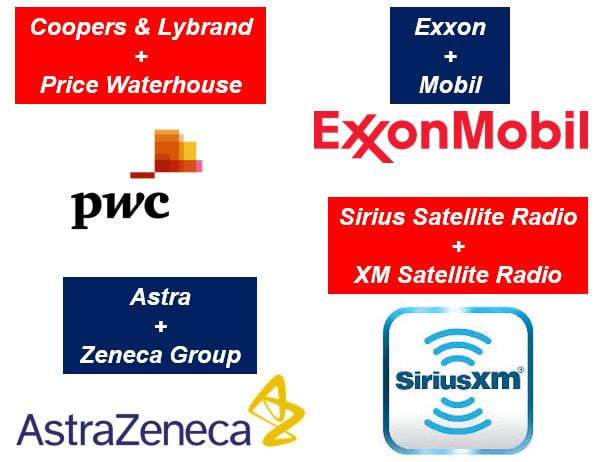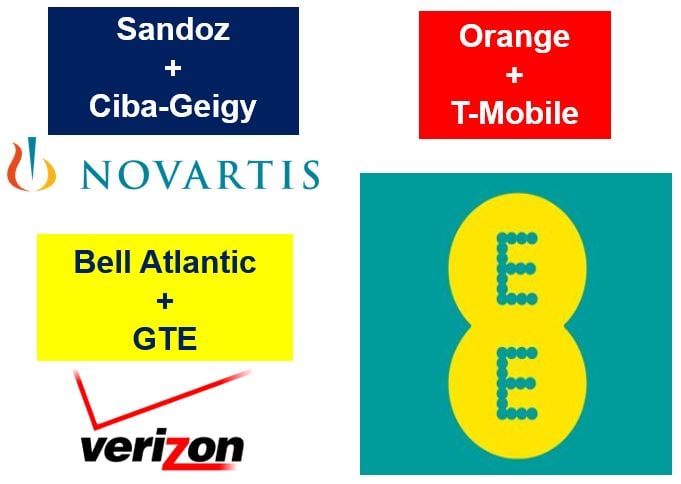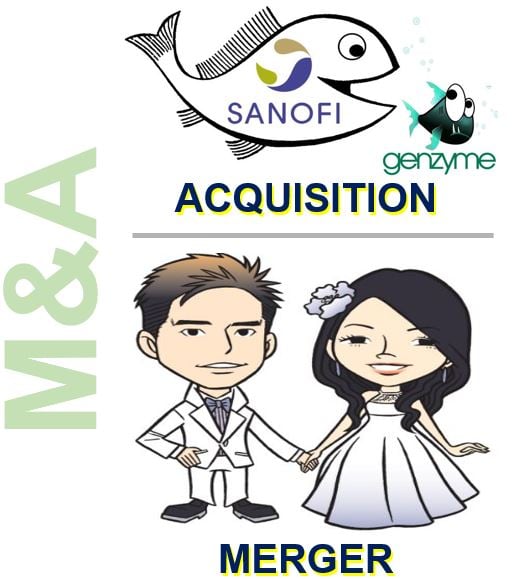A company Merger is a fusion of two companies – two firms get married and become one.
Technically speaking, the two companies are of similar size for a merger to occur. If one is much larger than the other, it is usually called an acquisition. However, the term ‘merger’ has broadened over the past couple of decades and often includes the amalgamation of two commercial enterprises of different sizes.
If the two merging companies were competitors, the fusion is known as a horizontal integration, if a supplier and customer marry, it is known as vertical integration.
If the two companies are in related but not identical industries, the amalgamation is called a concentric merger. In such cases, they can use the same skilled workforce and technologies to work in both industry segments, such as leasing and banking.

Motivation for a merger
In a merger, two existing businesses unite and become one new company. Firms decide to unite for a number of reasons – perhaps they wanted to expand into new segments, reduce costs, prevent an acquisition, or gain greater market share.
Greater economies of scale
If two businesses combine, they can take advantage of greater economies of scale – their unit costs are reduced. If your production suddenly doubles, for example, the cost of producing each unit declines, which means you can earn more profits. Smaller companies especially benefit from greater economies of scale after merging.
Imagine the seventh and eighth largest car-makers in the world merged – the new company would be further up the ladder. Perhaps the new entity would be the second or third largest. A larger company is better able to compete against the biggest players.
Geographical benefit
If a pharmaceutical multinational company dominates the European and Asian markets, while another one is strong in North & South America and Africa, a merger between the two businesses would mean that they had a strong foothold across the whole world. Merging is an effective way of rapidly becoming dominant in a new market.

Greater product range
A cash-rich company without interesting new products in the pipeline has a limited future, unless it can find a cash-strapped company full of promising new products in the development stage. If the two companies merged, the new entity would have both new products to sell in the short- and medium-term future plus lots of cash to launch them onto the market.
The combination of the two businesses involves a transfer of ownership, either as a cash payment between the two companies or a stock swap. The two companies surrender their stock and issue new shares as a new commercial enterprise.
Sometimes, the two merging companies adopt a new identity and branding. For example, John Doe Cakes Inc. and Jane Smith Pastries Ltd. become The Giant Baker Inc., with brand new logos, slogans, etc. If the two businesses have strong brand identities, the newly-created company may include both their names – e.g. John Inc. and Jane Ltd. become John-Jane Inc.
Novartis
Novartis International AG, the Swiss multinational pharmaceutical giant, ranked number one globally in sales, was the result in 1996 of a merger between Ciba-Geigy and Sandoz, both Swiss giants. They merged and became a new company with a completely unrelated name.
Astra Zeneca
AstraZeneca plc, the British-Swedish multinational pharmaceutical and biopharmaceutical company, was founded in 1999 when the British Zeneca Group and Swedish Astra AB merged. In this case, the new company contained the identities of the two merging businesses.

When a merger becomes an acquisition
Mergers are extremely difficult to implement and often end up taking the form of an acquisition – one company, the stronger or larger one, taking over the other.
The two companies have different cultures, which often result in problems when they move to restructure redundant managers and operations.
If the clashes are considerable, one of the two cultures eventually has to give way – the dominant one is typically from the larger or stronger company.

Merger rules and regulations
Mergers are carefully monitored by regulatory agencies. They decide whether a merger is legal. Without the green light from, for example, the Department of Justice and the Federal Trade Commission in the United States, mergers cannot go ahead.
If the top two pharmaceutical companies in the United States applied for the authorities’ blessing for a merger, their first concern would be the effect on competition and the protection of consumers and patients.
If the new entity had too high-a-percentage of the domestic market, the application for their amalgamation would probably be turned down.
The authorities would also have to determine whether the new super-giant would be able to manipulate prices in a way that could harm consumers and destroy the little competition that was left.
The European Commission is the regulatory body in the EU regarding mergers. The Commission’s rules regarding merger control were last updated in 2013.

Good and bad mergers
Without the mergers that have occurred throughout modern history, several well known companies and brands would not be where they currently are. Some merged entities are so successful that very few of us can remember a time when the two were separate businesses. Where would J.P. Morgan be without Chase, or Disney without Pixar?
On the other hand, many mergers have been absolute disasters. Often with horror, we have watched companies amalgamate and then run into the ground, collapsing into commercial comas. One of the greatest problems with mergers is loss of motivation by the workforce and culture clash.
AOL/Time Warner
At the height of the dot-com madness, Internet and email provider AOL (America Online) and the established media giant Time Warner merged in a $164 billion deal. Everybody thought it was a marriage made in heaven – how wrong they were!
Soon after their merger in the year 2000, the dot-com bubble burst and the slowdown of dial-up Internet access could not have come at a worse time for the new company. AOL/Time Warner reported a massive $45 billion write down in 2003, which led to an annual loss of $100 billion. In 2009, there was a corporate divorce – the two companies split.

ExxonMobil
In 1999, Mobil and Exxon signed an agreement for a $81 billion merger to form ExxonMobil. Apart from becoming the world’s biggest company, John D. Rockefeller’s Standard Oil Company of New Jersey (Exxon) and Standard Oil Company of New York (Mobil) – the 19th century former selves – were reunited.
The merger was so colossal that the Federal Trade Commission (FTC) required major restructuring of several of Mobil’s and Exxon’s gas stations in order to prevent the emergence of a giant monopoly. Even so, the FTC’s approval of the merger was unanimous.
Megan Ruesink, from Rasmussen College in Florida, USA, made the following comment regarding the Exxon and Mobil merger:
“ExxonMobil remains the strongest leader in the oil market, with a huge hold on the international market and dramatic earnings. So was the merger a success? Absolutely! Some even predict that after Shell’s recent acquisition of BG Group, that ExxonMobil is about to make yet another big move in oil by merging again. Only time will tell!”
The practice of corporate finance that deals with merging, dividing, selling and acquiring different companies to create new entities is known as M&A (mergers and acquisitions).
Reverse mergers
Backdoor Listing or Reverse Merger is what unlisted private companies do when they want to be listed in a stock exchange but wish to avoid having an initial public offering (IPO). The private company seeks out a failed listed company – a listed shell company – and either acquires it or buys it. After the transaction is completed, the private company has got into the stock exchange ‘through the back door’, hence the term ‘backdoor listing’.
According to etymonline.com, the verb ‘to merge’ appeared in the English language in the 1630s with the meaning ‘to sink in or plunge’, it came from Latin Mergere ‘to dip in, plunge, immerse’. With its modern business meaning, the verb appeared in 1726 in Britain.
Specialized vocabulary
Below, you can see some words that are used in the world of “mergers and acquisitions,” their meanings, and examples of how we can use them in a sentence:
Merger
A merger is the combination of two companies into one new legal entity, often with a new name.
Example: “The merger of the two telecommunications companies resulted in a more extensive network coverage and customer base.”
M&A
M&A stands for mergers and acquisitions, which refers to the consolidation of companies or assets through various financial transactions.
Example: “The M&A deal between the software firms was aimed at consolidating their technologies and market share.”
Acquisition (the same as Takeover)
An acquisition is the process where one company purchases most or all of another company’s shares to gain control of that company.
Example: “The tech giant’s acquisition of the startup allowed it to access innovative artificial intelligence technology.”
Takeover (the same as Acquisition)
A takeover is the act of assuming control of a company by purchasing a majority stake in its stock.
Example: “The board prepared for a potential takeover after a rival business disclosed a significant share purchase.”
Hostile Takeover
A hostile takeover is an acquisition attempt by a company or individual against the wishes of the target company’s board of directors.
Example: “The CEO braced for a hostile takeover after an aggressive competitor started buying up shares.”
White Knight
A White Knight is a friendly investor or company that acquires a corporation at fair consideration when it is facing a hostile takeover by another aggressor.
Example: “The company welcomed the white knight investor who offered favorable terms amidst the looming threat of a hostile takeover.”
Bear Hug
A bear hug is an offer to buy the shares of a company for a much higher price than what is being traded on the stock market, often used to acquire a resistant target company.
Example: “The smaller company received a bear hug from a larger firm, proposing a deal too generous to reject despite their initial reluctance to sell.”
Golden Parachute
A golden parachute refers to significant benefits or compensation promised to a company executive if they are forced out of a company after a merger or takeover.
Example: “The CEO’s contract included a golden parachute clause, ensuring a substantial payout in the event of a merger.”
Poison Pill
A poison pill is a strategy used by companies to thwart hostile takeovers by making the company less attractive to the acquirer, such as by allowing other shareholders to purchase additional shares at a discount.
Example: “To prevent the takeover, the company’s board adopted a poison pill that would flood the market with cheap stock if a single buyer tried to acquire a controlling stake.”
